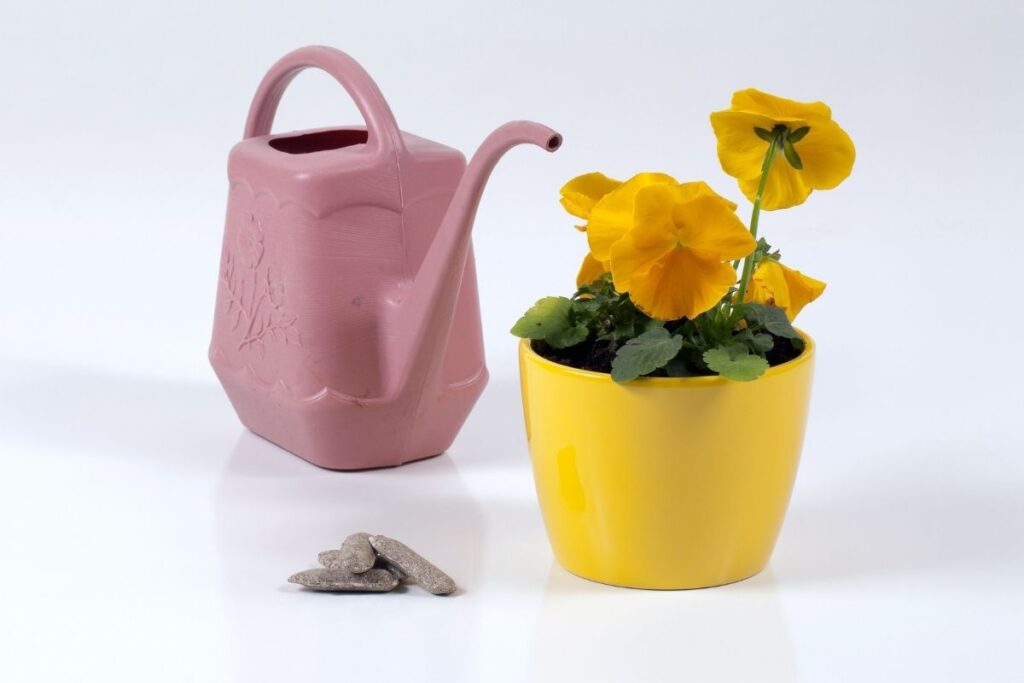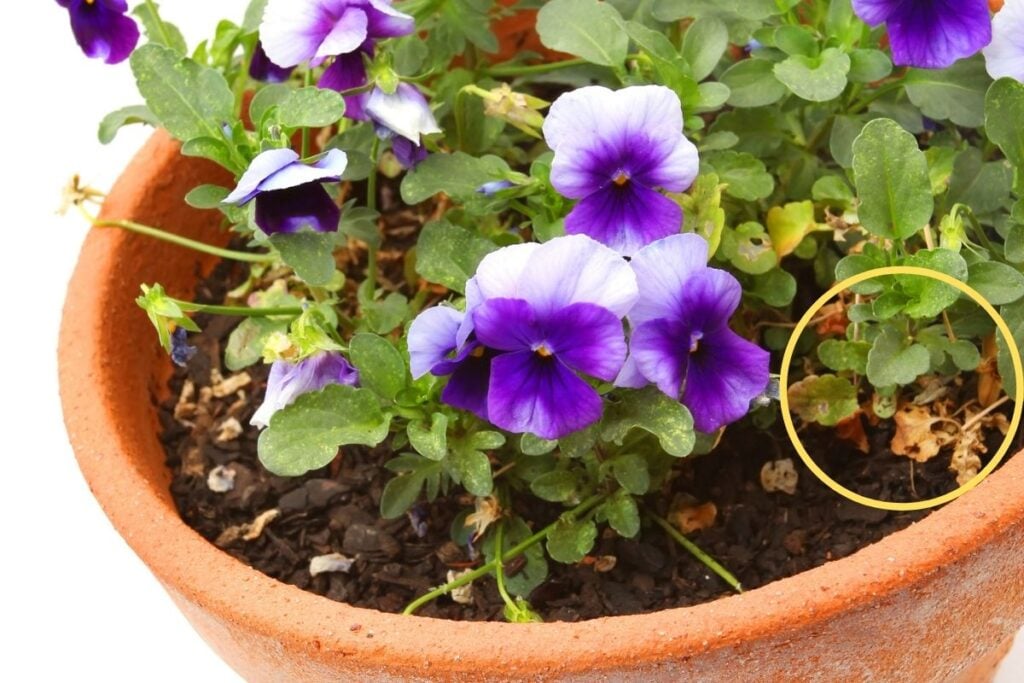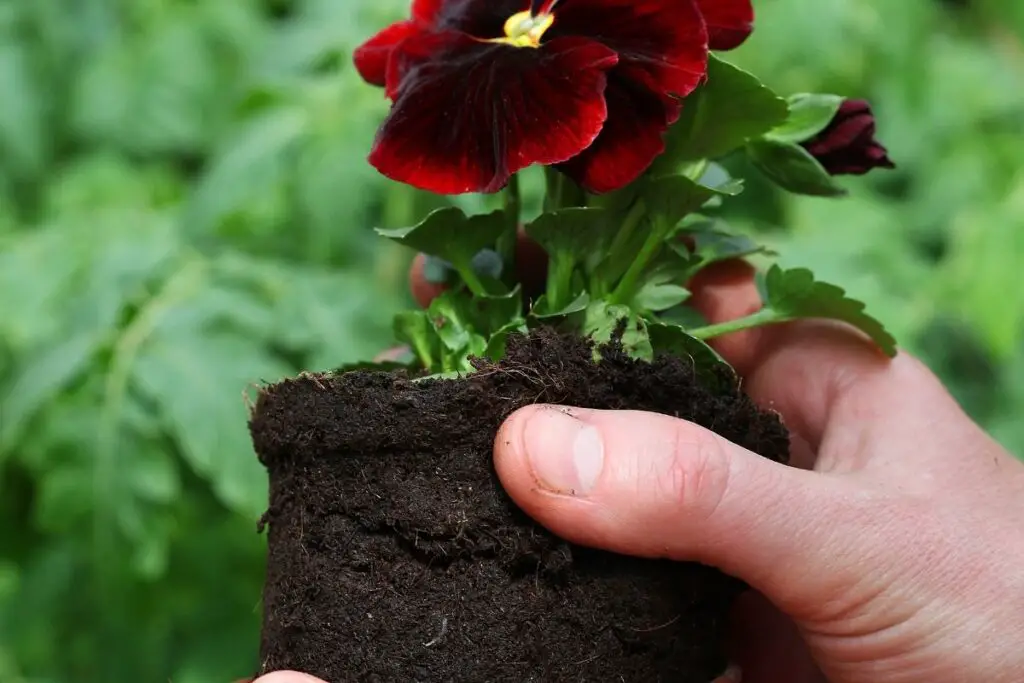Pansies are colorful flowering plants that give your garden a vibrant and stunning look with excellent fragrance. But, sometimes pansies can face many problems, and most of them occur due to incorrect watering techniques.
So, in this article we shall learn can pansies be overwatered and what problems can occur due to incorrectly watering your pansies.
Pansies can be overwatered, just like any other plant. Overwatering can cause various problems in pansies like edema, root rot, pest infestations, and fungal diseases. You need to identify the early signs of overwatering and take the necessary steps to safeguard your pansy from wilting.
It sometimes gets difficult to identify the overwatering problems in the pansies. Some common signs include yellow leaves or wilted and droopy leaves. There are other signs which we will discuss later in the article.
Overwatering can be fixed, and your pansy can be revived if proper treatment is done. Negligence will only kill your pansies.
Today’s article will discuss the symptoms, effects, preventions, and how to save your overwatered pansies.

Overwatering the pansies
Overwatering has always been a problem for all plants. We, as gardeners, might think that giving them more water will help them to grow faster. Well, that is not at all the case.
You must allow your plant and the soil bed to dry up before you perform another watering cycle.
Pansies are sun-loving plants that enjoy growing in cool weather conditions. You need to understand that pansies do enjoy cool weather conditions, but they do not enjoy damp conditions.
Moreover, damp conditions will only give rise to other problems, pest infestations, and fungal diseases.
Pansies need water only when the soil starts to dry up due to the dry weather conditions or exposure to the sun for a long time.
Because they remain under the sun for six hours, this stay might dry up the soil quickly. Only then can you water the pansies.
Other than frequent watering, another problem that can cause overwatering issue is the quality of the soil. Pansies like growing in well-draining soil.
If the soil bed does not have a sound drainage system, it won’t drain the excess water. It will hold that water, resulting in overwatering.
You must prepare the soil bed in a way that it drains the excess water and at the same time retains enough moisture required for the absorption of the crucial nutrients from the soil.
Overwatering and underwatering difference
It can be difficult for the gardeners to understand whether the plant is suffering from overwatering or under-watering.
You can try checking the stems and roots of the pansies to know whether the plant is suffering from overwatering or not. If the stems feel soft and mushy, then your pansies are probably suffering from overwatering.
But, if the base of the pansy soil bed is dry and hard, it is suffering from underwatering.
When your plant is suffering due to overwatering, it will start to look pale and yellow. In contrast, the leaves will become wilted and start curling if your plant is not getting enough water.
One of the common signs of both overwatering and underwatering in the pansies is droopy leaves.
Pansies like to grow in cool weather conditions. Because they are sun-loving plants, staying under the sun for longer than four to six hours may make the soil dry.
In this condition, you need to provide water and keep them hydrated.
Without proper hydration, the flowers and the leaves will start to look worse.
The same goes for overwatering. Applying too much water to the pansy soil bed and the plant will result in droopy, mushy, and soaked leaves and root rot.
An easy way to know whether your pansy is suffering from overwatering or not is to check the soil bed with your finger.
If the soil is moist and clayey enough and the mud gets stuck in your finger, then your pansy bed is in no need of water. But if the soil bed feels dry and a little hard, then it is time you water your pansy bed.
Also read: How Much Water Does A Pansy Need? (Pansy Water Requirements)
What are the signs of an overwatered pansy?

Let us see the common signs or symptoms to identify overwatered pansies.
Looking for gardening supplies? We have tested 100's of products before recommending them to you guys. Check out our best pick below:
| Image | Gardening Supplies | Best Price? |
|---|---|---|
 Top
Top Top
Top | Raised Garden Bed Kit | Check On Amazon |
 | XLUX Soil Moisture Meter, Plant Water Monitor, Soil Hygrometer Sensor for Gardening, Farming, Indoor and Outdoor Plants, No Batteries Required | No Results |
 Top
Top Top
Top | 82 Pcs Garden Tools Set and Extra Succulent Tools Set | Check On Amazon |
 | Joeys Garden Expandable Garden Hose with 8 Function Hose Nozzle, Lightweight Anti-Kink Flexible Garden Hoses, Extra Strength Fabric with Double Latex Core, (50 FT, Black) | No Results |
 Top
Top Top
Top | Dual Chamber Compost Tumbler | Check On Amazon |
 Top
Top Top
Top | Sunnyglade Plant Stakes | Check On Amazon |
 Top
Top Top
Top | Organic Cold Pressed Neem Seed Oil | Check On Amazon |
 Top
Top Top
Top | Mighty Mint Gallon :-Insect and Pest Control Peppermint Oil | Check On Amazon |
 Top
Top Top
Top | Scotts DiseaseEx Lawn Fungicide | Check On Amazon |
 Top
Top Top
Top | Jacks Classic 20-20-20 All Purpose Fertilizer | Check On Amazon |
 Top
Top Top
Top | 30,000 Seeds Pollinator Attracting Wildflower Mixture | Check On Amazon |
 Top
Top Top
Top | Survival Vegetable Seeds Garden Kit-Over 16,000 Seeds | Check On Amazon |
Yellow leaves
When you keep watering the pansies, you are constantly suffocating the root system without knowing whether the plant is absorbing the water or not. And when the roots are getting suffocated, they fail to absorb the nutrients and moisture from the soil.
If the roots cannot absorb nutrients and moisture from the soil, the plant and the leaves fail to get the nutrients, resulting in the leaf’s yellowing.
When you overwater the pansies, the leaves start becoming pale and start spreading.
Also read: Why Are My Pansy Leaves Turning Yellow? (Causes+How To Fix)
Droopy leaves
You might think that because pansies like cold weather, watering them now and then will benefit their growth. But that is not true.
The soil must support proper drainage, or it will hold excess moisture and keep the pansies soaked. If your pansies do not have a sound drainage system, they can get overwatered.
This might create fungus and mold in the pansies, harming and making the leaves droop.
Also read: Why Is My Pansy Drooping? (Possible Problems+How To Fix)
Dying leaves
When you overwater your pansies, or the soil is not draining the excess water, the leaves die. This happens due to a lack of nutrients.
If you don’t address the problem fast, the leaves will start getting affected one by one and die. Ultimately the whole plant will die if there are no leaves left.
Also read: Why Do My Pansies Keep Dying? (Possible Causes+How To Fix)
Stunted growth
If your pansies are suffering from overwatering, they will have stunted growth. Due to excess water, the root system fails to breathe due to suffocation.
It becomes difficult for the plant to receive the essential nutrients from the soil required for growth. Thus the lack of nutrient absorption results in stunted growth in the pansies.
Also read: How To Make Pansies Bloom More?
Brown spots
When your plant is wet for a long time, the leaves start producing brown spots. This is a sign of some leaf spot diseases, which are caused mainly due to overwatering.
If your plant is experiencing these fungal diseases, you need to stop watering immediately for some time until the soil gets dry.
Brown spots can result from other problems, so inspect the plant thoroughly to ensure that the problem is overwatering.
Also read: Why Are My Pansy Leaves Turning Brown? (Causes+How To Fix)
Root rot

One of the common problems caused by overwatering is root rot. This happens when the leaves and the plant stay damp for a long time.
One reason that can cause root rot is the poor quality of the soil. Pansies do not like standing in water or staying in damp conditions.
If your soil bed does not have a sound drainage system, they fail to drain the excess water. Due to staying in water for a long time, the root system gets suffocated. Due to this, the roots become mushy.
The plant doesn’t absorb the nutrients and moisture from the root. As a result, the plant becomes weak. The root changes its texture and also turns brown.
You start getting a foul odor from the soil. This tells you that your pansies are suffering from root rot.
Signs of root rot are yellow leaves, brown spots, foul smell, mushy, brown, and stinky roots.
Diseases
When the pansy plants are standing in the water or the leaves are damp for a long time, the plant becomes prone to different kinds of fungal diseases. One is root rot which I have already discussed in the previous point.
Other diseases include powdery mildew, downy mildew, and different other leaf spot diseases.
Another disease that is caused due to overwatering is black root rot caused by the pathogen Thielaviopsisbasicola.
These diseases result in sunken rotten tissues, black spots, and plant discoloration, which ultimately progresses to the death of the plant.
So you must take immediate steps to save your plant from these problems before they start killing your plant.
How to save an overwatered pansy?
It takes at least one week for your pansy to recover from overwatering. It depends on the different factors, including proper sunlight, good drainage, and proper watering techniques.
- Stop watering your pansies for a while and let them dry out.
- Ensure that your pansies are receiving enough sunlight throughout the day. This will help the soil to recover from the sogginess.
- When your pansy is showing signs of overwatering, remove the affected leaves. The affected leaves may give birth to diseases, and that might spread.
- Due to the root rot, the existing bed might have some fungus infection. First, remove the affected roots gently. And then, you can plant your affected pansy in some other place in the garden to revive it.
- You may add compost or mulch to the soil bed to improve the drainage. This will help absorb the excess moisture from the soil bed.
- If there is a pest infestation or fungal infection in pansies, remove the pests and the fungus (mold or powdery/downy mildew). To remove the pests, you can use cotton balls and rubbing alcohol and remove the affected leaves for fungus.
- After this step, you can apply some organic cures to your pansies. For example, neem oil.
- If any pansies are on the verge of dying, you might have to remove that whole plant and dispose of it. This will save the other plants.
How to prevent overwatering of your pansies?
- The first thing to do is choose a good site for the pansies to receive enough sunlight.
- Avoid overhead watering. Sometimes, when you water from the top of the plant, the water stays in the leaves and remains damp, and invites other issues. Water close to the soil.
- Before watering, check the soil. If the soil feels clayey and sticky, avoid watering.
- Do not overcrowd the pansies. Overcrowded pansies fail to receive enough airflow.
- Soil plays an important role here. Make the soil bed well-draining. Consider adding compost to the soil to improve the quality.
- Give breaks in between the watering sessions.
Keep one thing in mind while watering your pansies. Pansies need only one inch of water every week for healthy growth.
Water your pansies regularly in the morning and let them get sunlight throughout the day. Avoid watering in the night as the water takes time to dry up.
Final words
Pansies are easy to grow. All they need is your care and attention. They will never disappoint if you give them all the importance and requirements that they need.
Along with proper water, they also need good sunlight, air circulation, and rich fertile soil. You need to feed a balanced fertilizer to your pansies to keep them strong and healthy.
Some gardeners may think that watering more will help the plant remain strong. But it only makes your pansy plant weak. Due to the excess water, the plants suffer.
Water your pansies but do not overdo it. Maintain gaps in between the watering sessions. Let the soil bed dry up, and then consider your next watering. Take good care of the plant, and do not avoid the symptoms your pansies are showing you.
Observe daily reactions of the pansies. It will help you recognize and determine the problem at the initial stage.
Ref: The University of Arkansas, Britannica, Utah State University, Wikipedia, The University of Georgia, The Pennsylvania State University, The Royal Horticultural Society.
